
Covington Township is a civil township of Baraga County in the U.S. state of Michigan. The population was 375 at the 2020 census.
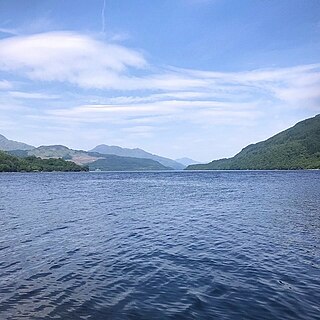
Loch Lomond is a freshwater Scottish loch which crosses the Highland Boundary Fault, often considered the boundary between the lowlands of Central Scotland and the Highlands. Traditionally forming part of the boundary between the counties of Stirlingshire and Dunbartonshire, Loch Lomond is split between the council areas of Stirling, Argyll and Bute and West Dunbartonshire. Its southern shores are about 23 kilometres (14 mi) northwest of the centre of Glasgow, Scotland's largest city. The Loch forms part of the Loch Lomond and The Trossachs National Park which was established in 2002.
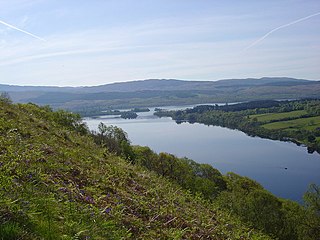
Loch Awe is a large body of freshwater in Argyll and Bute, Scottish Highlands. It has also given its name to a village on its banks, variously known as Loch Awe or Lochawe. There are islands within the loch such as Innis Chonnell and Inishail.

Arrochar is a village located near the head of Loch Long, on the Cowal peninsula in Argyll and Bute, Scottish Highlands. The village is within the Loch Lomond and The Trossachs National Park.
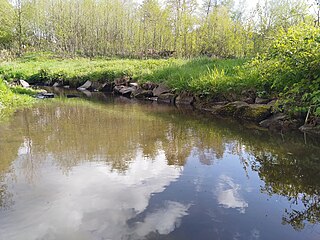
A body of water or waterbody is any significant accumulation of water on the surface of Earth or another planet. The term most often refers to oceans, seas, and lakes, but it includes smaller pools of water such as ponds, wetlands, or more rarely, puddles. A body of water does not have to be still or contained; rivers, streams, canals, and other geographical features where water moves from one place to another are also considered bodies of water.

Loughrea is a town in County Galway, Ireland. The town lies to the north of a range of wooded hills, the Slieve Aughty Mountains, and the lake from which it takes its name. The town's cathedral, St Brendan's, dominates the town's skyline. The town has increased in population in the late 20th and early 21st centuries. Although the town also serves as a commuter town for the city of Galway, it also remains an independent market town. Loughrea is the fourth most populous settlement in County Galway, with a population of 5,556 as of 2016.

Loch Tay is a freshwater loch in the central highlands of Scotland, in the Perth and Kinross and Stirling council areas. It is the largest body of fresh water in Perth and Kinross, and the sixth largest loch in Scotland. The watershed of Loch Tay traditionally formed the historic province of Breadalbane.
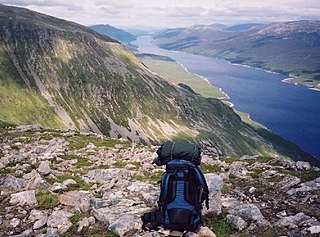
Loch Ericht is a freshwater loch on the border between the former Perthshire, now Perth and Kinross and the former Inverness-shire, now Highlands Council areas of Scotland. It has a north-east to south-west orientation. The village of Dalwhinnie lies at the north east end of the loch. Loch Ericht is the tenth largest freshwater lake in Scotland and has a good reputation for its trout fishing and Ferox trout.
Lochinver is a village that is located at the head of the sea loch Loch Inver, on the coast in the Assynt district of Sutherland, Highland, Scotland. A few miles northeast is Loch Assynt which is the source of the River Inver which flows into Loch Inver at the village. There are 200 or so lochans in the area which makes the place very popular with anglers. Lochinver is dominated by the "sugar loaf" shape of Caisteal Liath, the summit peak of nearby Suilven.

Creeslough is a village in County Donegal, Ireland, 12 kilometres (7 mi) south of Dunfanaghy on the N56 road. The small village overlooks an arm of Sheephaven Bay, with the population of the surrounding area engaged mainly in agriculture, mostly livestock rearing.
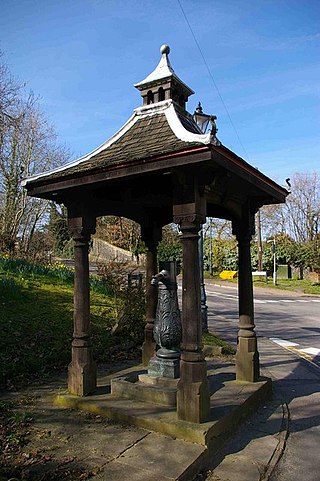
Watton-at-Stone is a village in the English county of Hertfordshire, situated midway between the towns of Stevenage and Hertford in the valley of the River Beane. The 2021 census showed a population of 2,614 living in 1,036 households. Watton-at-Stone is also a civil parish in East Hertfordshire District Council.

Watton is a market town in the district of Breckland in the English county of Norfolk, about 25 miles (40 km) west-southwest of Norwich and 14.5 miles (23.3 km) northeast of Thetford. The annual Wayland Agricultural Show in its west is one of the oldest one-day such shows in England.
Gogarloch is a residential area within South Gyle, Edinburgh, Scotland. It lies near South Gyle railway station and South Gyle Broadway, 4+1⁄2 miles (7.2 km) west of the city centre. Corstorphine and Wester Broom are nearby.
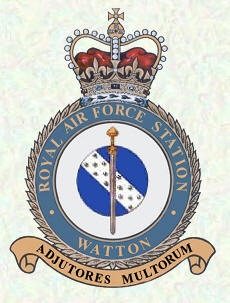
Royal Air Force Watton or more simply RAF Watton is a former Royal Air Force station located 9 mi (14 km) southwest of East Dereham, Norfolk, England.

Loch Lomond is a reservoir in the Santa Cruz Mountains near Lompico in Santa Cruz County, California. Part of the Santa Cruz Water Department system, it was created by building the Newell Creek Dam across Newell Creek – a tributary of the San Lorenzo River. The dam is an earth-fill barricade, measuring 190 ft (58 m) by 750 ft (230 m). It was financed by bond issuance, and completed in the Fall of 1960; impounded water first ran over the spillway in March 1963.

The Loch Lomond Vernal Pool Ecological Reserve is a nature reserve of 8.22 acres (33,300 m2) in the community of Loch Lomond in Lake County, California. It is one of 119 ecological reserves managed by the California Department of Fish and Game (CDFG). The ecological reserve system was authorized by the state legislature in 1968 for the purpose of conservation and protection of rare plants, animals and habitats.

The Water Horse: Legend of the Deep is a 2007 fantasy drama film directed by Jay Russell and written by Robert Nelson Jacobs, based on Dick King-Smith's children's novel The Water Horse. It stars Alex Etel as a young boy who discovers a mysterious egg and cares for what hatches out of it: a "water horse" which later becomes the fabled Loch Ness Monster. The film also stars Emily Watson, Ben Chaplin and David Morrissey.

The Bury and Thetford, also known as the Crab and Winkle Line, was a railway line in England. It was formed of the Watton and Swaffham Railway, founded in 1866 as an independent venture by the Thetford and Watton Railway Company. Freight services commenced in January 1869, with passenger services in October 1869. The line ran from Thetford, via Watton to a junction with the Lynn and Dereham Railway at Swaffham and was completed in 1875. The extension to Swaffham cost £72,000,

















